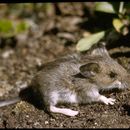Habitat
(
İngilizce
)
EOL authors tarafından sağlandı
Deer mice inhabit nearly all types of dry-land habitats within their range: short-grass prairies, grass-sage communities, coastal sage scrub, sand dunes, wet prairies, upland mixed and cedar forests, deciduous forests, ponderosa pine forests, other coniferous forests, mixed deciduous-evergreen forests, juniper/piñon forests, and other habitats (Holbrook, 1979; Kaufman and Kaufman, 1989; Ribble and Samson, 1987; Wolff and Hurlbutt, 1982). Few studies have found microhabitat features that distinguish the deer mouse, and some studies have come to different conclusions regarding habitat structure preferences (Ribble and Samson, 1987). For example, Vickery (1981) found that deer mice appeared to prefer areas with moderate to heavy ground and mid-story cover to more open ground areas, whereas others have found more deer mice in more open than in more vegetated areas (see Kaufman and Kaufman, 1989).
Trophic Strategy
(
İngilizce
)
EOL authors tarafından sağlandı
Deer mice are omnivorous and highly opportunistic, which leads to substantial regional and seasonal variation in their diet. They eat principally seeds, arthropods, some green vegetation, roots, fruits, and fungi as available (Johnson, 1961; Menhusen, 1963; Whitaker, 1966). The nonseed plant materials provide a significant proportion of the deer mouse's daily water requirements (MacMillen and Garland, 1989). Food digestibility and assimilation for most of their diet have been estimated to be as high as 88 percent (Montgomery, 1989). Deer mice may cache food during the fall and winter in the more northern parts of their range (Barry, 1976; Wolff, 1989). They are nocturnal and emerge shortly after dark to forage for several hours (Marten, 1973).
Research
(
İngilizce
)
EOL authors tarafından sağlandı
Scientists at Harvard University have found that deer mice living in Nebraska’s Sandhills quickly evolved lighter coloration after glaciers deposited sand dunes atop what had been much darker soil. http://news.harvard.edu/gazette/story/2009/08/mice-living-in-sand-hills-quickly-evolved-lighter-coloration/
- lisans
- cc-by-3.0
- telif hakkı
- Harvard University

